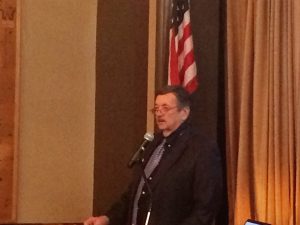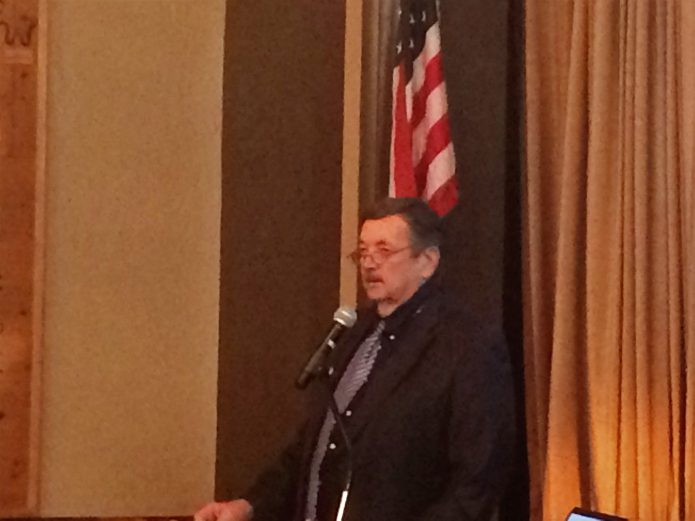
Imperial Irrigation District Board Chairman James Hanks addresses a gathering of local business, farming and civic leaders at the annual COLAB breakfast held Friday, March 16, at Stockmen’s Club in Brawley.
The Imperial County and Imperial Irrigation District (IID)’s message was hopeful and focused on progress in the Imperial Valley at the 2018 Coalition of Labor, Agriculture and Business (COLAB) breakfast event held at Stockmen’s Club in Brawley on Friday, March 16. It also highlighted the host of challenges faced by the county and IID, some of which—like the Salton Sea—are common to both agencies.
Imperial County Supervisors Chairman Ray Castillo was the first to speak. In his opening remarks, he reported that the county’s unemployment rate has dropped to 17 percent, down from prior months and years when unemployment has lingered over 20 percent in the county. For those outside of the Valley, 17 percent likely seems quite high, but Imperial County has always faced high unemployment rates. When the unemployment rate drops—even a little—it is a sign of progress and is worth noting.
Castillo also pointed out the strength of the county’s agricultural economy and cited a 2016 study that both evaluated the farming industry and celebrated the growth and stability of agriculture in the county. According to the study, agriculture had a net impact on the county’s overall economy valued at $4.5 billion. This figure includes multipliers—or the impact agriculture had on revenues across all industries in the county.
One more issue Castillo spoke on was the Salton Sea, noting there has been progress in the last year in addressing issues at the Sea, but there are still challenges ahead. He said the Imperial County Air Pollution Control District has been and will continue to work with IID and others on the development of what is known as best available control measures (BACM) or on-the-ground projects to address air quality issues at the Sea.
IID Board Chairman James Hanks, the second speaker, also discussed the Salton Sea. He said that a critical sign of progress at the Sea is the recently-adopted State Water Resources Control Board (Water Board) Stipulated Order, drafted jointly by IID, Imperial County and the San Diego County Water Authority, with support from the State and environmental groups. He said key elements of the Stipulated Order are the annual milestones the State must meet in carrying out its phased approach to restoration and the Water Board’s continuing jurisdiction over the restoration program.
Hanks further noted that for the first time other Colorado River Basin States are acknowledging that the Sea is a part of the river system. As a result, he said, the Sea has become linked to the efforts to develop a Drought Contingency Plan (DCP) that would outline how a shortage on the river would be addressed among the Basin States and Mexico (beyond the guidelines already determined under an interim program adopted in 2007).
Hanks also highlighted the Quantification Settlement Agreement’s positive impact on IID’s water budget, stating that the annual net revenue from the transfers with the San Diego County Water Authority and Coachella Valley Water District currently total about $90 million and supplement the $71 million received from IID’s water users. Transfer revenue will help with the building of a new reservoir in IID’s service area that could provide more than 3,000 acre-feet of storage. The reservoir is currently in a design phase and undergoing environmental review.
Hanks finished his presentation stating that there needs to be continued cooperation among water users within the Imperial Valley.
